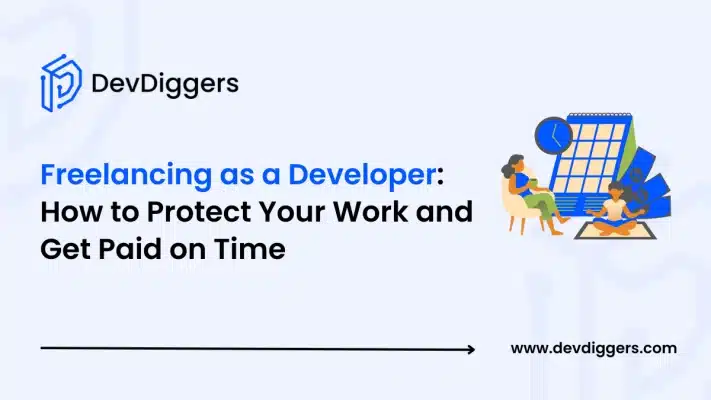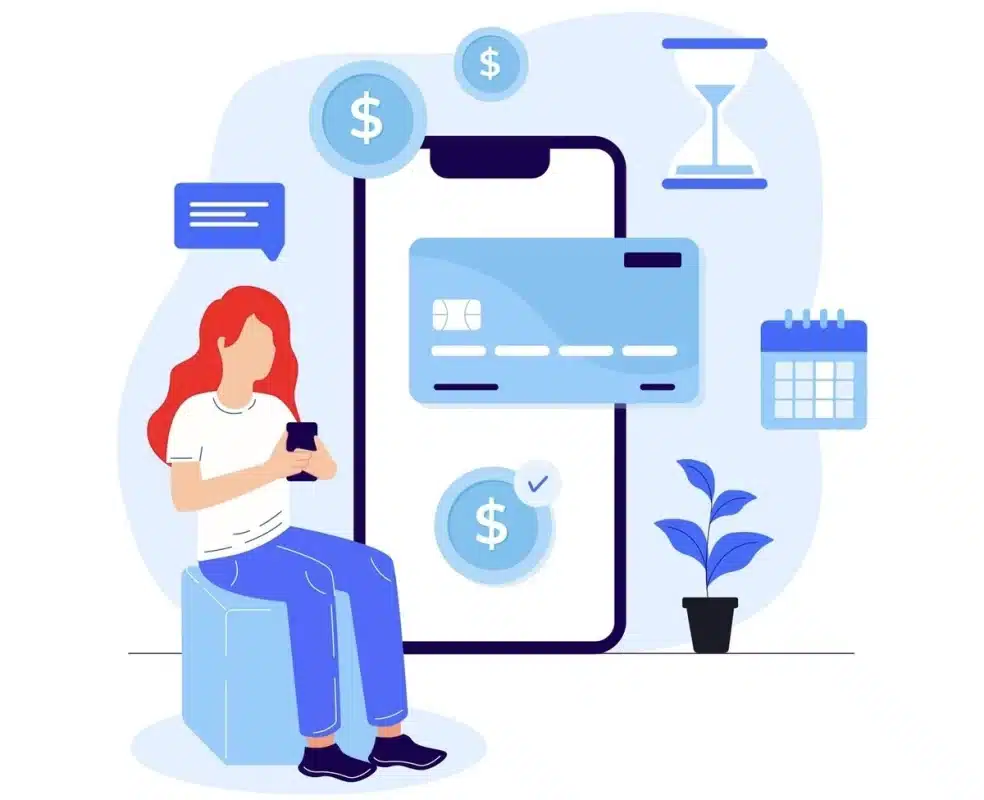- Step 1: Make It Official – Set Up Your Business the Right Way
- Step 2: Keep Your Work Yours – Protect Your Code and IP
- Step 3: Get Paid – Every. Single. Time
- Step 4: Master Client Relationships Like a Pro
- Bonus: List of the Legal Documents for Freelance Developers
- Final Thoughts: Protect Your Work, Get Paid, and Thrive
Freelancing as a Developer: How to Protect Your Work and Get Paid on Time

- Step 1: Make It Official – Set Up Your Business the Right Way
- Step 2: Keep Your Work Yours – Protect Your Code and IP
- Step 3: Get Paid – Every. Single. Time
- Step 4: Master Client Relationships Like a Pro
- Bonus: List of the Legal Documents for Freelance Developers
- Final Thoughts: Protect Your Work, Get Paid, and Thrive
As a developer, freelancing seems like the ideal: flexible hours, no supervisor hovering over your neck, and the possibility to work in pajamas. But then reality hits. Clients disappear when payments are due, your code gets used without credit, and projects expand without a paycheck in sight. Sound familiar?
If you’re tired of chasing invoices and wondering if your work is legally protected, you’re in the right place. Let’s break down how to safeguard your freelance career, keep your work secure, and — most importantly — get paid on time.
Step 1: Make It Official — Set Up Your Business the Right Way

If you’re freelancing without a business structure, you’re basically walking a legal tightrope. When learning how to start freelancing as a web developer, one of the first things to consider is setting up a proper business entity. You can choose one of these options:
- Sole Proprietorship. Easiest setup but offers zero protection if a client sues you.
- LLC (Limited Liability Company). Separates your personal assets from your business so your savings aren’t wiped out in a lawsuit.
- S-Corp. Great for tax savings but comes with extra paperwork.
And when you’re making decent money or working with multiple clients, an LLC is a solid middle ground — it keeps things simple while protecting you from legal headaches.
Contracts: Your New Best Friend
A solid contract is like a shield against shady clients. If you don’t have one, you’re gambling with your income.
You don’t need to be a legal expert to create the contract. Platforms like Lawrina — lawrina.org — offer ready-to-use templates, including professional services agreements, freelance contracts, and IP assignment agreements, making it easy to find the right legal document for your needs.
But if you decide to make it by yourself, here are the key sections to include:
- Scope of Work: What you’re doing, what you’re not doing, and how many revisions are included.
- Payment Terms: Hourly or fixed rate? Upfront deposits? Late fees? Spell it all out.
- Intellectual Property (IP) Rights: Who owns the final product? Make sure it’s clear.
- Kill Clause: What happens if the project gets canceled? (Hint: You should still get paid for work completed.)
- Dispute Resolution: No one wants to go to court. Define a process for handling disagreements upfront.
Step 2: Keep Your Work Yours — Protect Your Code and IP

Who Owns Your Code?
Without clear terms, clients might assume they own everything you create. But do they?
- Work-for-Hire Agreements: The client owns the code once they’ve paid in full.
- Licensing Agreements: You retain ownership but license it for their use.
- Open-Source vs. Proprietary: Know when to protect your work versus sharing it with the world.
Unless your contract explicitly states that ownership transfers to the client after full payment, the default assumption in many jurisdictions is that you, the developer, own the rights to your code.
This is why clarifying ownership in your contract is non-negotiable. If you plan to reuse parts of your code for future projects, include a clause allowing you to retain rights to your original work while granting the client a license to use the code for their specific needs.
On the other hand, if a client demands full ownership, consider adjusting your rates — because exclusive rights to your work should come at a premium. Always clarify this in your contract — don’t leave it up for interpretation.
Escrow and Upfront Payments
Ever had a client disappear mid-project? To avoid working for free, use escrow services. These platforms hold funds until project milestones are met.
Better yet, require an upfront deposit — at least 30-50% of the project fee. If a client hesitates, consider it a red flag.
Limit Access to Your Code Until Payment Clears
Use Git repositories to track changes and prove your contributions, ensuring you have a clear record of your work. Be mindful of access control — never hand over full code access before receiving the final payment to protect yourself from non-paying clients.
Additionally, using non-disclosure agreements (NDAs) can help safeguard your work from being misused or shared without your permission.
Step 3: Get Paid — Every. Single. Time

How to Spot Clients Who Might Ghost You
Before taking on a project, do a little digging to make sure you’re not walking into a nightmare client situation. Check evaluations and quotes from other independent contractors who have collaborated with them first.
A quick search on platforms like Upwork, Fiverr, or LinkedIn can give you insights into their reputation. If there’s little to no feedback available, that doesn’t necessarily mean they’re a bad client — but it does mean you should proceed with caution.
One of the best ways to test a client’s reliability is to request a partial upfront payment before you begin work. Legitimate clients won’t hesitate to put down a deposit, while shady ones will suddenly have excuses.
Also, be on the lookout for red flags — vague project descriptions, reluctance to sign a contract, or sudden urgency to start immediately without discussing key details. If something feels off, trust your instincts and consider walking away before you invest time in a project that may never pay off.
Payment Terms That Keep Your Cash Flow Steady
To maintain a steady cash flow, structure payments in phases so you get paid progressively as the project moves forward. Automated invoicing tools like PayPal, Stripe, or QuickBooks can streamline the payment process, ensuring invoices are sent and tracked efficiently.
You can also include late fees in your contract to discourage overdue payments — because your time is valuable, and clients should respect your schedule.
What to Do If a Client Won’t Pay
If a client vanishes:
- Send formal payment reminders.
- Use a demand letter template to push for payment.
- If they still refuse, small claims court or a debt collection agency may be your next step.
Either way, the key is to be proactive — don’t let unpaid work slide, or you’ll set a precedent that makes it easier for clients to take advantage.
Step 4: Master Client Relationships Like a Pro
Ever had a client say, “Can you just add this one small thing?”—and suddenly, your project has doubled in size? That’s scope creep, and if you don’t control it, you’ll find yourself working overtime for free.
- Define Project Limits: Clearly state what’s included (and what isn’t) in your contract.
- Be Firm, but Professional: “Happy to add that! Here’s my rate for additional work.”
- Charge for Extras: If they want more, they need to pay more.
A good client relationship isn’t just about delivering great work — it’s about setting expectations from the start. Clients may not always realize when they’re pushing boundaries, so it’s up to you to guide the process. The more transparent you are about your workflow, pricing, and response times, the smoother the collaboration will be. If a client continuously asks for extras without additional payment, remind them that quality work takes time and effort — and that you’re running a business, not a charity.
Nobody likes endless emails or clients expecting instant replies at midnight. Set clear response time expectations so clients know when and how to reach you — this keeps communication smooth and manageable.
And instead of juggling scattered messages, use project management tools like Trello or Asana to track progress, deadlines, and tasks all in one place. You can use other tools to make a great connection with clients. You will spend less time sorting through emails and more time concentrating on the work that really pays the bills when everything is orderly.
Freelancing Developer vs. In-House Developer
If you’re a developer, chances are you’ve debated whether to freelance or work in-house. Both routes have special benefits and drawbacks; the best one for you will rely on your financial priorities, work style, and professional objectives.
Freelancing as a software developer offers freedom and flexibility — you choose your projects, set your own rates, and work from anywhere. If you enjoy variety and want to build a diverse portfolio, freelancing lets you work with multiple clients across industries.
However, the trade-off is that you’re responsible for finding clients, managing contracts, handling invoices, and securing payments. Stability can be an issue, especially when dealing with inconsistent work or late payments.
On the other hand, in-house development provides job security, benefits, and structured career growth. As a full-time employee, you receive a stable paycheck, health insurance, and possibly retirement benefits — things that freelancers must arrange on their own.
You also have access to a team, mentorship, and company resources, making it easier to develop your skills and collaborate on larger projects. However, in-house roles can sometimes feel restrictive, with less control over the projects you work on and a fixed salary that may not grow as quickly as freelance rates.
Ultimately, the decision comes down to what you value most — the freedom of freelancing or the stability of an in-house role. Some developers even blend both worlds, taking on freelance projects while working full-time to maximize income and experience.
Bonus: List of the Legal Documents for Freelance Developers
Below are the key legal documents every freelance developer should have in their toolkit.
- Freelance Contract (Independent Contractor Agreement): A freelance contract is the foundation of your working relationship with a client. Ensuring all sides are in agreement precisely outlines the extent of work, payment arrangements, timeframes, and ownership rights. This contract is crucial for preventing scope creep, setting boundaries, and making sure you get paid on time.
- Professional Services Agreement: For long-term projects or retainer-based work, a professional services agreement provides additional clarity. Unlike a one-time freelance contract, this agreement covers ongoing work, recurring tasks, and expectations for an extended working relationship. If you’re planning to work with a client for months (or even years), this document ensures everything is structured and legally sound.
- Non-Disclosure Agreement: A NDA protects your ideas, code, and any confidential information shared during a project. If your client requires discretion — whether it’s a startup idea, proprietary software, or sensitive user data — this contract legally prevents them from disclosing or misusing that information.
- Intellectual Property Assignment Agreement: Who owns the code once the project is done? If this isn’t addressed in your contract, it could lead to ownership disputes down the line. An IP Assignment Agreement clearly defines who holds the rights to the code, ensuring you’re properly credited or compensated. This is especially important if you want to retain licensing rights instead of handing over full ownership.
- Payment Agreement: Nothing ruins freelancing as a web developer faster than clients who ghost on payments. A payment agreement sets clear payment schedules, upfront deposits, late fees, and the consequences of non-payment. This document is your best friend when it comes to ensuring clients stick to agreed-upon payment terms — and it gives you legal backing if they don’t.
- Statement of Work (SOW): The SOW is like a roadmap for your project. It outlines exactly what you’re delivering, when, and for how much — eliminating ambiguity. A well-drafted SOW prevents misunderstandings by breaking down the project into clear deliverables, timelines, and expectations, so there’s no confusion about what the client is paying for.
Final Thoughts: Protect Your Work, Get Paid, and Thrive
Freelancing isn’t just about coding — it’s about running a business. If you want to avoid nightmare clients, delayed payments, and legal messes, you need to be proactive.
- Use contracts.
- Protect your work.
- Get paid on your terms.
Think of freelancing like building an app. Without a solid framework, things break, users (clients) get frustrated, and security vulnerabilities (unpaid invoices) creep in.
A well-structured freelance business operates the same way — when you set clear expectations, enforce boundaries, and use the right tools, everything runs smoother, and you don’t waste time fixing avoidable problems.
At the end of the day, freelancing should give you freedom, not financial anxiety. By setting clear boundaries, leveraging legal tools, and structuring payments wisely, you’ll ensure freelancing remains a dream job, not a financial disaster.
Protect your work, value your time, and build a career that works for you — not the other way around.

Abhijit Sarkar
Hi, I’m Abhijit Sarkar. I am deeply passionate about creating engaging content and exploring. My journey includes gaining valuable experience in content writing and creating useful resources for my readers.

Leave a Reply